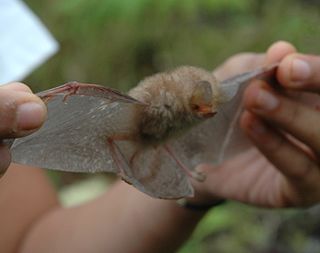
The European free-tailed bat is a species of free-tailed bat found in the Old World. Other common names include the bulldog bat and the mastiff bat because of the presence of wrinkling on the snout. This bat is found in the Mediterranean region of Europe and in scattered locations across Asia at altitudes from sea level to 3100 m. The range of distribution is from the Canary Islands and Madeira through the whole Mediterranean area, Asia Minor, the Caucasus and the Middle East. In the north to southern France, southern Germany, Switzerland, Croatia and Bulgaria. It was reported from Korea in 1931, but has not been sighted on the Korean Peninsula since that time. Populations in Japan, Taiwan and Korea are now considered to be a separate species Tadarida insignis.

The Natal free-tailed bat is a species of bat in the family Molossidae, the free-tailed bats. It is endemic to the island of Mauritius. It is known from fewer than five locations in its range, but it is common at a few sites. It roosts in caves, and it is considered to be an endangered species due to disturbance of its cave habitat.
The Damara woolly bat is a nocturnal insectivorous species of vesper bat in the family Vespertilionidae found in Africa. This species typically has reddish brown fur on its back and white fur on its abdomen. Its natural habitat is moist savanna, although it has also been shown to inhabit woodlands and coastal forests. These bats typically weight about 10 g, and have a low aspect ratio, as well as low wing loading.

Hardwicke's woolly bat is a species of vesper bat in the family Vespertilionidae.

The small woolly bat is a species of vesper bat in the family Vespertilionidae. It is found only in Malaysia and is little known. It is only slightly larger than the Kitti's hog-nosed bat, one of the smallest mammals in the world. The small woolly bat weighs 2.5 to 4 g.

The lesser woolly bat is a species of vesper bat in the family Vespertilionidae. It is found in Botswana, Central African Republic, Democratic Republic of the Congo, Ivory Coast, Ethiopia, Gabon, Ghana, Guinea, Kenya, Liberia, Malawi, Nigeria, South Africa, Tanzania, Zambia, Zimbabwe and rarely Ethiopia. Its natural habitats are subtropical or tropical moist lowland forests, dry savanna, and moist savanna. Members of this species typically have a dark greyish brown fur with whitish tips scattered throughout.

The clear-winged woolly bat is a species of vesper bat in the family Vespertilionidae. It is found in Brunei, Indonesia, Malaysia, and the Philippines. Members of this species are relatively small, typically weighing about 4.5g and mainly forages in the understory of tropical forests. This species also presents a unique variant of echolocation that is a higher intensity and lower frequency than most other kerivoula calls. The sort range calls are distinguishable from the long range orientational echolocation calls by peak frequency and duration.

The Indonesian tomb bat is a species of sac-winged bat in the family Emballonuridae. It is found only in Indonesia.

Patrizi's trident leaf-nosed bat is a species of bat in the family Hipposideridae. It is found in Eritrea, Ethiopia, and Saudi Arabia. Its natural habitats are subtropical or tropical dry shrubland and caves. It is threatened by habitat loss.
Duke of Abruzzi's free-tailed bat is a species of bat in the family Molossidae. It is found in Cameroon, Central African Republic, Democratic Republic of the Congo, Ivory Coast, Gabon, Ghana, South Sudan, and Uganda. Its natural habitats are subtropical or tropical dry forest, subtropical or tropical moist lowland forest, and moist savanna. It is threatened by habitat loss.

The little free-tailed bat is a species of the genus Chaerephon in the family Molossidae. It is widely distributed across Africa and islands around the continent.

The Midas free-tailed bat is a species of bat scientifically classified in the order Chiroptera and the family Molossidae. It is distributed from western Africa to Saudi Arabia and further south. Its natural habitats are dry savanna, moist savanna, woodlands and hot deserts. The more southern are also known to live around large rivers or the swamps. It is threatened by habitat loss.

The Trevor's free-tailed bat is a species of bat in the family Molossidae. It is found in Central African Republic, Democratic Republic of the Congo, Ivory Coast, Ghana, Guinea, Nigeria, South Sudan, and Uganda. Its natural habitats are subtropical or tropical dry forests and moist savanna. It is threatened by habitat loss.

Peters's flat-headed bat is a species of bat in the family Molossidae and the monotypic genus Platymops. It is found in Ethiopia, Kenya, and South Sudan. Its natural habitats are dry savanna and rocky areas.
The lenis woolly bat is a species of bat in the family Vespertilionidae. It is found in South and Southeast Asia.

The Madura horseshoe bat is a species of bat from the family Rhinolophidae. Current taxonomy treats the Madura horseshoe bat as a species separate of the Sulawesi horseshoe bat and not including parvus, but Csorba et al. (2003) recognizes both as subspecies of the Sulawesi horseshoe bat. It is known only from seven specimens from Madura Island and the Kangean Islands in Indonesia, and its type locality is Soemenep, Madura Island. The species is listed as Vulnerable on the IUCN Red List, and it suffers from habitat loss due to limestone excavation and deforestation for logging and agriculture in its habitat. It is also unknown whether or not the Madura horseshoe bat lives in any protected areas. The species is cave-roosting and most likely independent of water, foraging in primary forest.
The Krau woolly bat is a species of bat in the family Vespertilionidae. It is found in Southeast Asia, Brunei, and Indonesia.















